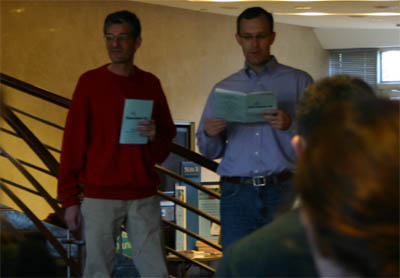 Bora Zivkovic and Anton Anton Zuiker Kick Off the Conference |
The last two years I have had the pleasure of attending Seed Media’s blogtogether.org’s yearly Science Blogging conference in Research Triangle (See previous years’ posts 2007 here and 2008 here, here, and here). Each year I come away from the conference brimming with so much blog-fodder that I end up needing an entire day to cover it all.
Unlike previous years, I decided to go eco-friendly and only grab the free swag I knew I would use. Two books Edge’s What Have You Changed your Mind About? and The Best American Science Writing 2008 will both be regular companions with me throughout the year, as their previous volumes have done. I’ll be looking forward to Open Laboratory 2008, when it gets posted to LuLu, as the previous editions also made great relaxation reading.
One bit of new swag I couldn’t resist was from Small Science Zines, little books you can print out on a sheet of paper and distribute proselytizing science subjects. I picked up two of these, Endless Spirals and Snake Legs & Wisdom Teeth and found them delightfully illustrated in a rough indy-magazine sort of flavor. There’s something rebellious about this concept, reminiscent of distributing fliers for punk rock bands, only its science, which is appropriate, since science is a perpetual rebellion of ideas.
This was also the first road trip for my brand-spanking-new Toyota Prius. Vicky and I both had turns driving it, each of us trying to drive in such a way as to bring our average MPG up higher and higher. When we got home, our average MPG was 41.9, just shy of the magical 42. I think we can get that extra tenth of a decimal place with a few more days of driving slower than senior citizens.
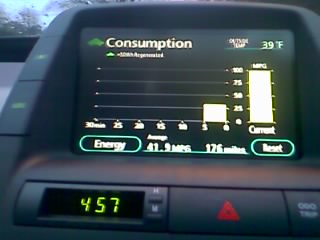 Prius at 41.9 MPG |
I’ve got eight fascinating sessions to cover, lots and lots of blog-fodder. So I hope to tackle two of these a day for the rest of the week.
Science Fiction in Science Blogs
“[science fiction] is the herald of possibility. It is the plea that someone should work on the future. Yet it is not prophecy. It is the dream that precedes the dawn when the inventor or scientist awakens and goes to his books or his lab saying, ‘I wonder whether I could make that dream come true in the world of real science.’” – L. Ron Hubbard*
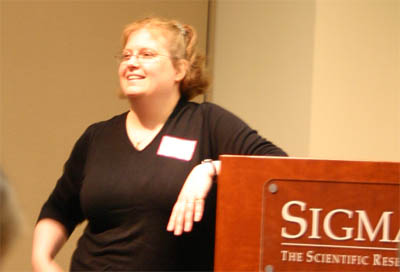 Stephanie Zvan of Almost Diamonds Blog |
Readers of this blog know that lately I’ve been trying to run a once-a-week flash fiction (see category Pure Speculation for the stories), or get something posted to 365Tomorrows. I’ve been criticized in the past for mixing my love of Science Fiction with my love of Science, but I always defend this practice. I see Science Fiction as the vision to inspire the Scientific discipline that enriches our lives in every day’s news.
Stephanie Zvan of Almost Diamonds moderated this first of sessions I attended as Scio09, and the session I was most surprised and delighted to see. Before the conference, Zvan posted some questions about Science Fiction and science blogging, and io9 posted a summary of the survey results, which I was shocked to find very negative, but then, reading the survey results myself, found them extremely positive (So in addition to their lame BSG spoilers, I now have another reason to dislike io9 (I’ll read it, but I won’t like it. So Thpppt!)).
Although much of the discussion was geeking out about what authors and stories people liked rather than whether SF promotes science, I think the way people became so animated when discussing their SF favs was a demonstration of its power. People get energized by their fandom, and that’s a good thing.
Consider one of my favorites, Star Trek. Valid complaints of Star Trek include its militaristic or communistic society (a debatable point) and its “maleable reality” or Treknobabble, but the series also represented a positive vision of the future. Some people, when they watch the documentary Trekkies only see a bunch of screwball fanatics, but I see a bunch of scientists, engineers, and doctors (albeit eccentric ones).
I was glad to see both Scicurious and Dr. Isis sing Star Trek’s praises. Phil Plait of Bad Astronomy is a huge Trek fan, even having debates about the show with Wil “Wesley Crusher” Wheaton.
Plait’s easily the best example of a science blogger who uses SF to educate. His status as a fanboy combined with his regular posts critiquing the science in the SF he encounters makes for an SF fan who takes it in with a critical perspective. That’s science.
Kim Gainer, English Professor at Radford University, brought up the important point that Science Fiction provides a medium for wrestling with the ethical questions in science. My whole novel Clones was such a thought experiment, dealing with the unique social dynamics of people raising child versions of themselves. Science Fiction stories about resurrecting Neanderthals or Wooly Mammoths give people the opportunity to philosophize about it, work out all the implications, decades before it happens.
Other participants brought up the opinion that some of the best SF there is concerns politics. “Vonnegut is the most important science fiction writer I’ve ever read,” commented one participant. SF Authors introduced many scientists to the political aspect of their professions, which was something I would not have ever imagined had I not attended.
The most insightful comment of the discussion, was when someone brought up the idea that science is inherently a speculative endeavor. “Every time you create an hypothesis you create an alternative universe for testing.” Science, therefore, is the practice of Science Fiction.
* Sorry to start this post off with a quote from a cult leader, but it’s a brilliant quote nonetheless.
The Wiki for this Session has a collection of responses from scientists and science fiction writers on the topic.
Science Online – middle/high school perspective
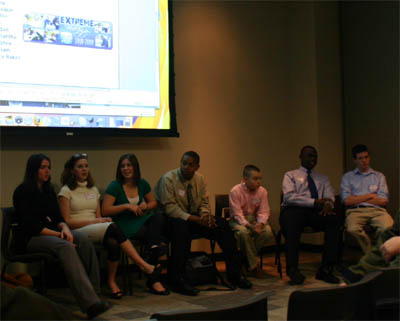 High School Perspective of Online Science |
Stacey Baker of Using Blogs in Science Education and a panel of her students from a private school I missed typing down gave a presentation/discussion about “How the Facebook Generation Does It.” Students today are using Twitter, Skype, AIM, and NING to facilitate discussions and collaboration among students in the same class and all over the world. Social networking into a profession or academic discipline is being built into the class structure.
Some of the more fascinating items discussed during the session dealt with the credibility of sources online. Baker mentioned that she would regularly slip bad online sources into a reference lists to see if the students would spot it. Wikipedia was cited as a great starting point for delving into any subject, but the students were not allowed to reference it directly. Instead, they must find their own references, or cite Wikipedia’s sources. An interesting dimension of this is the fact that Wikipedia is a plain-English interpretation of a source, and oftentimes students will go to the original source, only to find it incomprehensibly erudite.
I also learned about the concept of the Creepy Treehouse, where teachers or professors lure students into class participation in non-classroom settings, such as Facebook, Twitter, or blogs. The problem with these mediums is that if forces the students to manage two accounts for these services, one account for the classroom face and another for their personal face. I completely sympathize with the students on this, as I am not 100% comfortable with the fact that many of my professional colleagues have added me as a friend on Facebook, where they are grouped along with my old party friends from college.
Of course, the point was made, that the entire Internet is the Creepy Treehouse now. I got a taste of this at work, when I walked into a room just as a coworker was demonstrating how much fun it was to Google people’s names. “Good morning Ryan! I bet we’ll get some great results for you with your blog and all that,” he said, and promptly submitted my name to Google Images. Then this picture came up in the first page of results. My coworkers had a good laugh about it, but, if I was a teacher, I’d hate for the Principal of the school to see that (Remember kids: MySpace is Forever).
In a later session, Bora Zivkovic would make a very encouraging point on this issue, that this may simply be a generational misunderstanding, and that, as time passes and the cultural understanding changes with the technology, having pictures of yourself intoxicated online will cease being the big deal it is today. This groked with me, as I understand that everyone has a non-professional face, and Google has no means to distinguish between them.
My favorite moment of this session came when someone asked what it was like to grow up in a world with all of this information at your fingertips. I personally remember all those long afternoons at the college library, sifting through stacks of books for any bit of supporting evidence to scavenge into a paper, which would inevitably have the formatting tweaked to stretch it into 10-15 pages. What was it like for today’s high school students?
“We can’t imagine what it was like for you all,” one student remarked.
“Thank god for older people who are able to access computers and contribute online materials,” said another.
The Semantic Web in Science
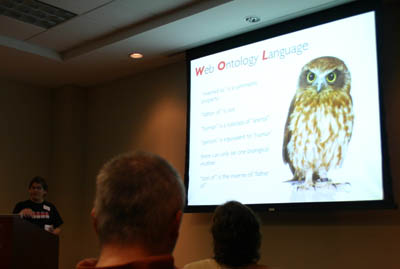 John Wilbanks |
John Wilbanks, Vice President of Science Commons gave a fairly technical overview of the Semantic Web, its promise, and what needs to be accomplished for it to fulfill its promise. I’ve been extremely excited about the Semantic Web for a very long time, too long a time. It concerns me that I’m not seeing the benefits of this idea yet: an Internet packed, not just with links between different data, but information about the links themselves.
Part of Google’s page-ranking algorithm concerns how many web sites are linking to a particular site where a keyword appears, known as the “Bag of Words” paradigm. The problem with this approach is that we don’t know why these other sites are linking to this first page. The Resource Description Framework offers a means to correct this oversight, providing a description of the type of link being used:
 RDF-Triples Credit: W3C |
Every arrow in the above example represents an RDF Triple: subject, predicate, object. In the World Wide Web, with every link we all ready have a vague concept of subject and object, but With this addition of predicate, we have the ability to triangulate links into concepts.
Imagine a search engine that knows when you type “primate,” it should also look for “monkey,” “ape,” and “chimpanzee,” or a search engine that knows when you enter “wood,” that you are looking for forestry information and not carpentry. That is the revolution at which the semantic web hints, but never seems to manifest.
Why is that? One point brought up in the session is the lack of Semantic Web software. Currently Nepomuk is, to my mind, a leading contender with its beta Semantic Desktop, but anyone who can code an effective WYSIWYG semantic web tagging tool would strike it rich. In a few years, when I intend to be pursuing a doctorate in Computer Science, I want the Semantic Web to be my focus. There is simply so much to do in this field.
And why isn’t everyone working on it? The fact is, there is too much data online for people to go back through everything all ready out there and add all of this metadata and not enough incentive. It’s like the current attempts to switch to hydrogen cars. There are no hydrogen fuel stations, because there aren’t cars demanding them, and there won’t be cars without the fuel stations. We won’t have a semantic web until we have a web coded with semantic data, and people won’t have the incentive to code in semantic data until there are popular tools making use of that data.
Interesting note: yesterday I mentioned Star Trek’s influence in science, well, for the semantic web, there is a Star Trek Ontology, which is used for hypotheticals where real world examples would be too complicated.
The NeuroCommons is one example of the semantic web in action in science. Wilbanks encourages people to download it and create their own versions as it is open-source.
The Web and the History of Science
GG of Skulls in the Stars, Brian Switek of Laelaps, and Scicurious of Neurotopia v2.0 moderated this session discussing why science bloggers should cover the history of science and find ways to work it into their current posts.
I’ve occasionally posted history of science stories, like that of Harry K. Daghlian and Kudryavka. One of the participants mentioned that communicating the history of science was an “Exercise in storytelling,” and I found this observation insightful. History is an attempt to craft, not just stories, but meaningful stories out of the past.
The discussion also delved into the importance of science history for understanding why facts are facts. Like the fact that our current Anthropogenic Climate Change science is founded on science extending back to 1804, giving it 200 years of credibility. Being able to conduct the same basic experiments, same basic proofs that were performed a century ago make the experiments accessible to the average person. The historical approach allows us to take problem back in time, to a context where it was comprehensible to the layman.
My favorite, and most conceptually challenging portion of the discussion dealt with the mythologizing of science history. We tend to talk about science in terms of inevitable forward progress, but it was really a great deal of starts and stops, trackbacks, and endless debates. Scicurious brought up the intriguing example of Bayer inventing heroin and marketing it as the non-addictive morphine originally, but today we pretend as though everyone always knew heroin was addictive. Will future generations learn that “Pluto is a plutoid” without learning about how much ire demoting Pluto from its planetary status caused?
Another problem raised concerning this habit of mythologizing our historical figures is our tendency to turn them into heroic caricatures of themselves. “There’s Darwin the ideal and Darwin the man,” one participant noted, and I realized the obverse of this is true as well. We demonize those we disagree with, for instance William Jennings Bryan is portrayed purely as a religious nut in Science Blogs, but the man was extremely socially progressive, and was fighting Evolution on the moral grounds that Scopes’ textbook argued the inferiority of non-whites and endorsed eugenics.
No one in science today would endorse eugenics or the genetic inferiority of non-whites; however, we do ourselves a disservice, and our rhetorical opponents a disservice, by not acknowledging the complexities of the history. Especially when they can go read the original textbook online and see that we aren’t telling the whole story when we invoke the Scopes Trial.
Science and Art
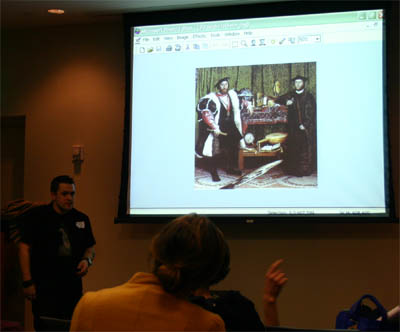 Glendon Mellow of Flying Trilobite |
Glendon Mellow of the Flying Trilobite hosted a very enjoyable session, where he started out by covering what he considered the various types of science art:
Scientific Illustration: drawings to illustrate the content of an article. I post many of these for links having to do with dinosaurs or extinct creatures.
Fine Art: a high-culture art, often inspired by science. An interesting and somewhat disturbing example would be Mark Quin’s sculpture of himself made out of his own blood.
Art Inspired by Scientific Subjects: self explanatory, includes optical illusions and Salvador Dali. Awhile back I blogged the MoMa exhibit Design and the Elastic Mind (my photos of it here), which I would put into this category.
Science Fiction: interesting examples of this were invented ecosystems and the speculative dinosaur project.
To this list, I think I would add Found Art. This would include putting a cast of dinosaur bones together into an action pose, propping up a taxidermied animal, mounting forminifera, or any other sort of museum display. A Cabinet of Curiosities would be a great example of found art. This form of art is much more scientifically rigorous, but also very creative. One attendee mentioned that there are many artistic choices in science, such as how to color astronomy photos to best bring out their details.
After the introduction, Mellow said that he felt his relationship with science was “parasitic,” where he’s getting a lot of inspiration from science, but doesn’t feel like he’s giving back. I was glad to see the overwhelming response from the room was essentially, Keep doing what you’re doing. That art inspires science, and scientific illustrations go a long way toward communicating scientific discoveries to the general public.
As part of this art communicating science, I would stress the importance of the metaphor as a tool for illustrating concepts. In Computer Science, we would be lost without metaphors. In fact, our Windows and Macintosh operating systems are basically a collection of metaphors for all the inner mechanical and electronic workings of our computers. Metaphors are indispensable in describing atoms and quantum physics. So writers take heed, remember the importance of metaphors in your work.
A few times the specter of the two cultures debate was raised, but I was glad that one attendee decided to shoot down the whole thing as “tedious.” I agreed with the idea that there are artists who see science as oppressive and scientists who see art as frivolous. These people have personal problems, not cultural ones, and need to free their intellects.
The reality is that there are not two cultures. Someone brought up a younger scientist, who grew up playing with Transformers Beast Machines and therefore had no problem relating biological to mechanical. Another raised the phenomena of Jurassic Park encouraging scientists to fact-check its many portrayals.
So the two cultures is a myth, propagated by scientists who don’t like art, and artists who don’t like science. The reality is that science inspires art, and art, science. The two cultures should continue to work toward our common good. Sessions like this, hosted by thoughtful people like Mellow, are this principle put to practise.
You can see the various artwork referenced at the Wiki for this Session. Highly recommended.
Science Online for Kids (and Parents)
“No compulsory learning can remain in the soul… In teaching children, train them by a kind of game, and you will be able to see more clearly the natural bent of each.” – Plato, the republic, Book VII
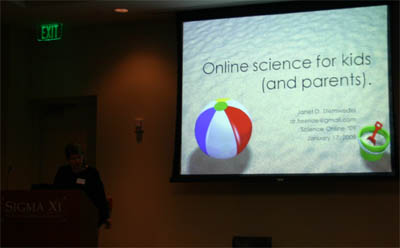 Janet Stemwedel of Adventures in Ethics and Science |
Janet Stemwedel of the Adventures in Ethics and Science blog ran a session that made a personal project in my life so much easier. I’ve wanted to compile a give-away CD at the science center of links to the best science sites for kids on the web. Dr. Freeride has done all the work on that, for which I am very grateful.
One of Stemwedel’s criteria for including a link, is that it be of interest to parent’s as well as kids. She cited Sesame Street’s habit of including lots of jokes and satire for adults to enjoy while watching the show with their kids. I think NASA’s Spaceship Spitzer cartoon does a great job of appealing to kids while sneaking in jokes and references for adults. Also the show is served in small doses, which is nice for not getting stuck in front of the monitor for long stretches of time.
Beyond the World Wide Web, I realized afterwards the resources available in Virtual Worlds. The International Space Museum, NASA’s COLAB, and the NOAA in Second Life are also fantastic playgrounds for parents to let their children do the exploring, while riding along over their shoulder to help them get the most out of the experience.
Crayon Physics was mentioned as a great science game. To that I would add the Federation of American Scientists’ free video game Immune Attack and Hopelab’s game ReMission, both of which involve flying around inside the human body, battling viruses and cancer cells. For physics, I’m currently playing Portal, which is witty and involves thinking about velocity and momentum in interesting ways, but the game is for older kids due to its complexity. Spore is a game that scores low and high marks in various areas from scientists, so, while the game is kid-friendly, parents need to be able to explain to kids why the depiction of biological and cultural evolution is somewhat misleading… or they might come away believing in Creationism.
Which brings up another issue for parents who want to weave science into the everyday fabric of their children’s lives, as Janet Stemwedel does, the problem of science anxiety. Dr. Stemwedel notes that much of science has changed since we were kids, Pluto was a planet and brontosaurus was a dinosaur. Parents might not feel qualified to teach their kids science, but they need to understand that science isn’t static, that it’s always changing. Continuing education is an important principle in every adult’s life, and the education of our children is a wonderful opportunity to practice it.
Extending the Virtual into the physical, I realized that Geocaching often offers wonderful opportunities for outdoor science lessons. Many contributors to this hobby require people to identify trees or answer other nature questions in order to find the cache. Kids can also collaborate with their parents to set up their own geocaches, including a bit of science trivia in order to locate it. If I were a kid, I would love to return to my cache year after year and see the growing list of signatures on it.
My recent most favorite example of a parent teaching their child science is the Energy Game Dr. Richard Feynman used to play with is father growing up, where he was challenged to answer where something got its energy (ie. a spring wound up by a person), and where that energy came from (person ate food), and where that came from, etc, until the energy chain was always traced back to the Sun.
Nature Blogging
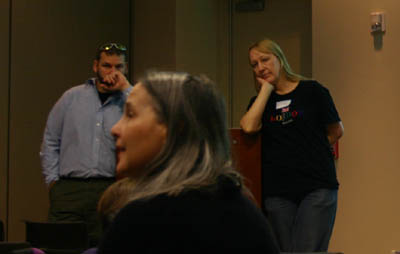 Kevin Zelnio of Deep-Sea News and Grrrlscientist of Living the Scientific Life |
Grrrlscientist of Living the Scientific Life and Kevin Zelnio of Deep-Sea News co-hosted this session, which I attended and Vicky snuck into. While I don’t consider myself a nature blogger, I do like to cover Take a Child Outside Week, and my flickr sets are much more about using museum specimens to catalogue what you find outside than taking inspiring photos.
A good deal of the session kept returning to the question of “What is Nature Blogging?” as opposed to science blogging. One participant made the insightful observation that Henry David Thoreau was a nature blogger, but not a science blogger. Someone else noted that The Origin of the Species was both scientifically rigorous and filled with natural philosophy.
Richard Carter, answered via Twitter, “Nature Blogs are unlikely to cover the large hadron collider.” To which a commenter replied, “I take that as a challenge.”
Another, related question, was “How much Science should be in Nature Blogs?” Several commenters agreed that including science definitely enhanced their reading experiences, and that nature blogs, because they tend toward a softer scientific emphasis, provide a “Lower barrier to entry” for their readers to understand the science they do bring into the mix. In other words, have fun, but sneak some science into the enchanting photography and emotional experiences.
Nature blogging isn’t a subset of science blogging because it includes people who post photos from their back yard, wondering about what they’ve photographed. Nature blogs, it was raised, are interwoven with advocacy. They bring attention to the myriad conservation efforts going on all around the world, and encourage people to participate in Citizen Science projects like the Audubon Christmas Bird Count.
It was at this point Vicky and I learned about the amazing website iNaturalist.org, where members upload photos of species they photography along with coordinates. The site has fantastic potential for citizen science, and Vicky has all ready signed up and started contributing to it. She sees the site as way to track decimated American Chestnut populations. Vicky has been uploading photos all night to keep up with the California submissions.
I would probably blog more outdoor excursions if I wasn’t so uptight about properly identifying the species I photograph outside. Museums have these convenient labels on everything, while outside is just so incredibly overwhelmingly biodiverse. The world outside is filled with the promise of adventure, overwhelmingly complex and inspiring in a way I find difficult to accurately articulate. I’m thankful for the bloggers out there who are able convey that sense of wonder.
Hey, You Can’t Say That!
 ideonexus Blocked at the Coast Guard Base |
In the interest of enabling attendees to speak candidly about personal conflicts they have experience between their professional or personal lives and their online persona, speakers were kept anonymous for this session (not sure how posting their names on the conference program affects this). It was suggested that all panelists should be referred to as {PZ1, PZ2, PZ3…} in honor of Science Blogs’ most controversial author, PZ Myers of Pharyngula fame, who couldn’t make it.
This session was also the most packed of all, and had some of the most interesting stories. PZ2 talked about how his employer wanted to put an editor on his blog, and how he expects to be fired any moment now for refusing to allow it. PZ3 talked about her employer took no interest in her personal blog until they thought they could benefit from its publicity. Another blogger talked about how he had to stop criticizing a company on his blog when he started receiving grant money from them.
One attendee talked about how someone dredged up an inflammatory post he had written years ago and submitted it to his present employer, demanding action. The employer, luckily, was sophisticated enough to realize the post was a personal one and did not represent the publication, but it does raise the idea of our online histories coming back to haunt us, not all of it under our control. Someone suggested that people should blog respectfully under their real name as a means of pushing the unfavorable websites down the search results.
I thought PZ3 had one of the most insightful observations, when she talked about the naivety of scientists, and their belief in intellectual honesty. It doesn’t occur to them that they can’t speak their mind.
“We need a bloggers union,” someone said, and someone else mentioned the Online News Association.
At the very end of the session, a moderator asked if there were any bloggers who worked for the Federal Government who had some stories to share. I didn’t think there was enough time left to squeeze in my experiences, but because I work for the Federal Government, on a Coast Guard base, I have to be extremely careful about my online actions while on my work computer.
Five years ago, I quite foolishly downloaded my ideonexus beta blog to my server at work to make some tweaks on my lunch break. It just happened that we were undergoing a security audit that week, and guess what they found when they looked at my computer?
I got pulled into the Project Manager’s office, where my blog, specifically a political rant, was pulled up in a browser window, being broadcast from my workstation to the intranet. After being properly chewed out, I was made to sign a statement that I would be fired if I ever screwed up like this again.
The real issue, I would learn later, wasn’t that I was using my workstation for non-work activities during my break, it was that I was using my computer to post political content that others could read. It is seriously illegal to use Federal property to promote a political ideology, and it would have been proper to fire me on the spot.
Recently, CGblog has me identified as an unofficial Coast Guard blogger; although, my blog really has very little to do with the Coast Guard, except for my post on Phytoremediation projects on base. This isn’t a big deal, as everyone at work knows I blog science and geekery for the local paper, but I do have two posts out there that could catch me some heat. One post brags about my ridiculously expensive tax-payer-funded chair and another jokes about getting away with having the Flying Spaghetti Monster on my desk.
Is there a Sword of Damocles hanging over my head?
Science Blog Networks, What Works, What Doesn’t
Cameron Neylon of the Science in the open, Deepak Singh of business | bytes | genes | molecules (bbgm), and several panelists from Science Blogs and members of Nature Network discussed the merits of community blogging versus indy (“Garage”) blogging.
I got a chuckle as a few participants refered to Science Blogs as “the Borg,” even by the people who blog there. On the plus side of not being part of a blogging community, is the fact that we indies have total freedom in how we design our blogs (even if some changes irritated my readers). One of the reasons I jumped the wordpress.com ship to roll my own blog again was the freedom to install whatever widgets I wanted in the sidebar.
At the same time, being a member of Science Blogs certainly has its appeal. Some participants talked about the increase in traffic they got from Sb, and others talked about how being part of Sb “legitimized” their blogs in some ways, that they could feel comfortable putting their blog on their CVs.
Comments from a few former Sb bloggers brought up the potential negatives of being part of the community, how they all get overshadowed by PZ Myers and that people assume all Sbers are militant Atheists.
Per Bora’s comments, the organization of Sb appears to give the bloggers a union of sorts. They have the power to get advertising they don’t like removed from the site, and have raised protest about their employer in the past.
My favorite line from the session pointed out that we are all online, and we are all part of a Science Blogging Community, “Google is the community.”
Comments
6 responses to “Science Online 2009”